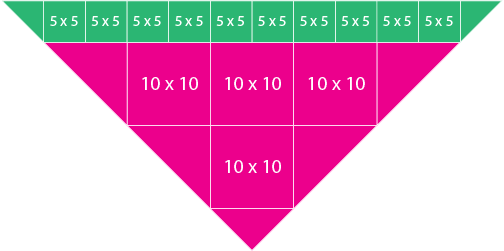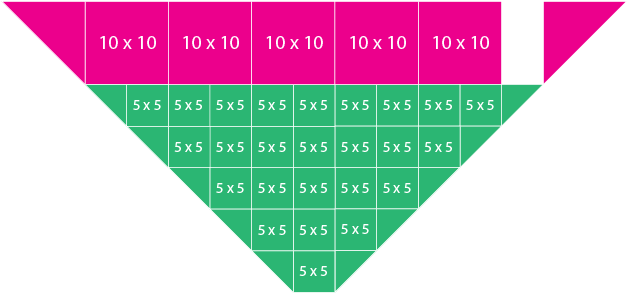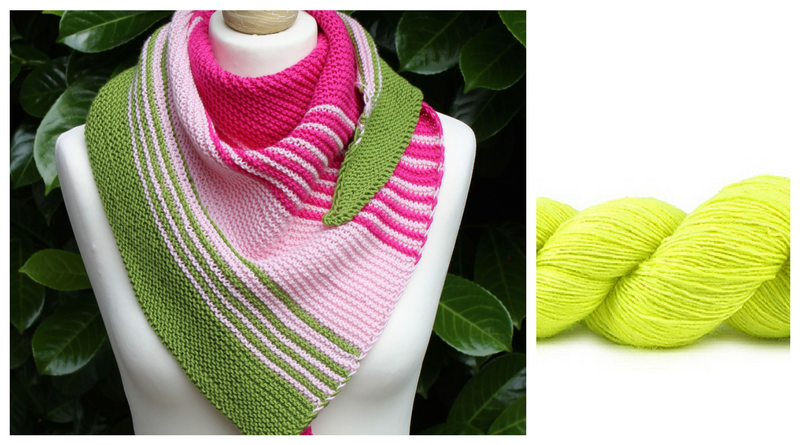Resizing Triangle Shawls: Adjustable Triangle Shawls
Welcome to Day 5 of the Adjustable Shawls series! Today, we’re talking about adjustable triangle shawls. What makes triangle shawls adjustable, and how does resizing triangle shawls work?
The Basics of Triangle Shawl Design
There is a whole bunch of information about triangle shawls available in my Shawl Design For Everybody series here on knitting.today. If you don’t know anything about triangle shawls and how they are constructed yet, feel free to browse the series and learn about
before proceeding.
Resizing Triangle Shawls
Triangle shawls using only one stitch pattern are adjustable and resizable by default. Make sure you use your kitchen scale as described in the post Your Most Important Tool when working from top down or when using stitch pattern modules.
For alignment of pattern modules in triangle shawls the same principles as outlined in the post on the math of adjustable shawls – What Makes Shawls Adjustable? – apply here, too.
Pattern Modules in Triangles
For triangles, things are a bit different: the stitch count is not fixed here. Usually, a certain amount of stitches is increased every few rows to form a triangle. Mostly, this increases are done near the edges. What we end up with is a different situation with pattern modules: in each section, there are “normal” modules (like the modules show above) and variants of these on each side of the triangles, where the increases are made.
In my knitting patterns, I mostly refer to these parts as “PATTERN NAME repeat”, “PATTERN NAME right side”, and “PATTERN NAME left side”. (The repeat is the “normal” module as shown above.)
Let’s look at an example for a 10 x 10 module. The lowermost triangle is a setup section, just ignore it for now. The first module repeat section consists of one normal panel plus one left and one right side panels. On the second module repeat there are three module repeats plus two side panels: the side panels in the first repeat generate the needed number of stitches for the two additional repeat modules in the second repeat.

This can be continued for as many module repeats you want. But what if we want to change the module size?
Well, if we switch from 10 x 10 to 5 x 5 modules, there isn’t any problem: the 5 x 5 module fits into one 10 x 10 module twice, so everything goes well as shown in the figure below.

But it does not work out the other way round. Why? Because we start with one 5 x 5 module and two side panels – and each module repeat adds two more repeats, the stitch counts are therefor 3*5, 5*5, 7*5, … which cannot be divided by 10 without remainder. Ever.

A possible solution is to start with two repeats and two side panels in the 5 x 5 module first repeat section, yielding stitch counts being multiples of 10 as needed for the 10 x 10 module section afterwards.
Summary: Resizing Triangle Shawls
Triangle shawls using only one stitch pattern (for instance, only use garter stitch or only one pattern repeat) are adjustable by default. To make triangle shawls with different stitch patterns adjustable, you have to make sure the stitch count before and after a pattern transition (changing the pattern within the stole) does not change.
Any questions so far? If yes, feel free to drop me a comment below!



Pingback: Knitting From Stash: Shawl Design Using Three Skeins of Sport Weight Yarn - knitting.today
Pingback: Knitting Adjustable Shawls and Making Shawls Adjustable - knitting.today